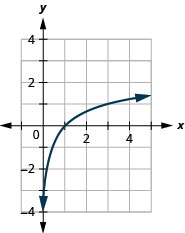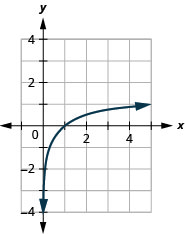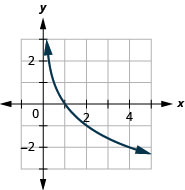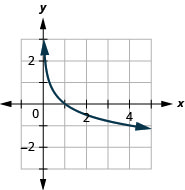5.2 Evaluate and Graph Logarithmic Functions
Learning Objectives
By the end of this section, you will be able to:
- Convert between exponential and logarithmic form
- Evaluate logarithmic functions
- Graph logarithmic functions
- Solve logarithmic equations
- Use logarithmic models in applications
Try It
Before you get started, take this readiness quiz:
1) Solve: [latex]{x}^{2}=81[/latex]
2) Evaluate: [latex]{3}^{-2}[/latex]
3) Solve: [latex]{2}^{4}=3x-5[/latex]
We have spent some time finding the inverse of many functions. It works well to ‘undo’ an operation with another operation. Subtracting ‘undoes’ addition, multiplication ‘undoes’ division, taking the square root ‘undoes’ squaring.
As we studied the exponential function, we saw that it is one-to-one as its graphs pass the horizontal line test. This means an exponential function does have an inverse. If we try our algebraic method for finding an inverse, we run into a problem.
[latex]\begin{align*} &\;&f(x)&=a^x\\ &\text{Rewrite with}\;y=f(x)\;&y&=a^x\\ &\text{Interchange the variables}\;x\;\text{and}\;y.\;&x&=a^y\\ &\text{Solve for}\;y.\;&\text{Oops!}\;&\text{We have now way to solve for}\;y! \end{align*}[/latex]
To deal with this we define the logarithm function with base [latex]a[/latex] to be the inverse of the exponential function [latex]f\left(x\right)={a}^{x}[/latex]. We use the notation [latex]{f}^{-1}\left(x\right)={log}_{a}x[/latex] and say the inverse function of the exponential function is the logarithmic function.
Logarithmic Function
The function [latex]f\left(x\right)={log}_{a}x[/latex] is the logarithmic function with base [latex]a[/latex], where [latex]a \gt 0[/latex], [latex]x \gt 0[/latex], and [latex]a\ne 1[/latex].
Convert Between Exponential and Logarithmic Form
Since the equations [latex]y={log}_{a}x[/latex] and [latex]x={a}^{y}[/latex] are equivalent, we can go back and forth between them. This will often be the method to solve some exponential and logarithmic equations. To help with converting back and forth let’s take a close look at the equations. See Figure 5.2.1. Notice the positions of the exponent and base.

If we realize the logarithm is the exponent it makes the conversion easier. You may want to repeat, “base to the exponent give us the number.”
Example 5.2.1
Convert to logarithmic form:
a. [latex]{2}^{3}=8[/latex],
b. [latex]{5}^{\frac{1}{2}}=\sqrt{5}[/latex]
c. [latex]{\left(\frac{1}{2}\right)}^{x}=\frac{1}{16}[/latex]
Solution
Step 1: Identify the base and the exponent.
[latex]\begin{align*}(a)&\;\;\;\;\;\;&(b)&\;\;\;\;\;\;\;&(c)&\;\\[2ex] {\color{red}{2}}^{\color{blue}{3}}&=8\;\;\;\;\;&{\color{red}{5}}^{{\color{blue}{\frac12}}}&=\sqrt5\;\;\;\;\;&{\color{red}{\left(\frac12\right)}}^{\color{blue}{4}}&=\frac{1}{16}\\[2ex] {\color{blue}{y}}&=log_{\color{red}{a}}x\;\;\;\;\;&{\color{blue}{y}}&=log_{\color{red}{a}}x\;\;\;\;\;&{\color{blue}{y}}&=log_{\color{red}{a}}x\\[2ex] 3&=log_{2}8\;\;\;\;\;&\frac12&=log_{5}\sqrt5\;\;\;\;\;&4&=log_{\frac12}\frac{1}{16}\\[2ex] \text{If } 2^3&=8, \text{ then } 3=log_{2}8\;\;\;\;\;&\text{If } 5^{\frac12}&=\sqrt5, \text{then } \frac12=log_5\sqrt5.\;\;\;\;\;&\text{If } \left(\frac12\right)^4&=\frac{1}{16}, \text{then } 4=log_{\frac12}\frac{1}{16}.\end{align*}[/latex]
Try It
4) Convert to logarithmic form:
a. [latex]{3}^{2}=9[/latex]
b. [latex]{7}^{\frac{1}{2}}=\sqrt{7}[/latex]
c. [latex]{\left(\frac{1}{3}\right)}^{x}=\frac{1}{27}[/latex]
Solution
a.[latex]{log}_{3}9=2[/latex]
b. [latex]{log}_{7}\sqrt{7}=\frac{1}{2}[/latex]
c. [latex]{log}_{\frac{1}{3}}\frac{1}{27}=x[/latex]
Try It
5) Convert to logarithmic form:
a. [latex]{4}^{3}=64[/latex]
b. [latex]{4}^{\frac{1}{3}}=\sqrt[3]{4}[/latex]
c. [latex]{\left(\frac{1}{2}\right)}^{x}=\frac{1}{32}[/latex]
Solution
a. [latex]{log}_{4}64=3[/latex]
b. [latex]{log}_{4}\sqrt[3]{4}=\frac{1}{3}[/latex]
c. [latex]{log}_{\frac{1}{2}}\frac{1}{32}=x[/latex]
In the next example we do the reverse—convert logarithmic form to exponential form.
Example 5.2.2
Convert to exponential form:
a. [latex]2={log}_{8}64[/latex]
b. [latex]0={log}_{4}1[/latex]
c. [latex]-3={log}_{10}\frac{1}{1000}[/latex]
Solution
Step 1: Identify the base and the exponent.
[latex]\begin{align*} (a)&\;\;\;\;\;\;&(b)&\;\;\;\;\;\;\;&(c)&\;\\[2ex] {\color{blue}{2}}&=log_{\color{red}{8}}64\;\;\;\;\;&{\color{blue}{0}}&=log_{\color{red}{4}}1\;\;\;\;\;&{\color{blue}{-3}}&=log_{\color{red}{{10}}}\frac{1}{1000}\\[2ex] x&={\color{red}{a}}^{\color{blue}{y}}\;\;\;\;\;&x&={\color{red}{a}}^{\color{blue}{y}}\;\;\;\;\;&x&={\color{red}{a}}^{\color{blue}{y}}\\[2ex] 64&=8^2\;\;\;\;\;&1&=4^0\;\;\;\;\;&\frac{1}{1000}&=log_{-3}\\[2ex] \text{If } 2&=log_864, \text{ then } 64=8^2\;\;\;\;\;&\text{If } 0&=log_41, \text{then } 1=4^0\;\;\;\;\;&\text{If } -3&=log_{10}\frac{1}{1000}, \text{then }\\ \;&\;&\;&\;&\;&\frac{1}{1000}=\frac{1}{1000}=10^{-3} \end{align*}[/latex]
Try It
6) Convert to exponential form:
a. [latex]3={log}_{4}64[/latex]
b. [latex]0={log}_{x}1[/latex]
c. [latex]-2={log}_{10}\frac{1}{100}[/latex]
Solution
a. [latex]64={4}^{3}[/latex]
b. [latex]1={x}^{0}[/latex]
c. [latex]\frac{1}{100}={10}^{-2}[/latex]
Try It
7) Convert to exponential form:
a. [latex]3={log}_{3}27[/latex]
b. [latex]0={log}_{x}1[/latex]
c. [latex]-1={log}_{10}\frac{1}{10}[/latex]
Solution
a. [latex]27={3}^{3}[/latex]
b. [latex]1={x}^{0}[/latex]
c. [latex]\frac{1}{10}={10}^{-1}[/latex]
Evaluate Logarithmic Functions
We can solve and evaluate logarithmic equations by using the technique of converting the equation to its equivalent exponential equation.
Example 5.2.3
Find the value of [latex]x[/latex]:
a. [latex]{log}_{x}36=2[/latex]
b. [latex]{log}_{4}x=3[/latex]
c. [latex]{log}_{\frac{1}{2}}\frac{1}{8}=x[/latex]
Solution
a.
Step 1: Convert to exponential form.
[latex]x^2=36[/latex]
Step 2: Solve the quadratic.
[latex]x=6,\;\overline{)x=-6}[/latex]
Step 3: The base of a logarithmic function must be positive, so we eliminate [latex]x=-6[/latex]
Therefore, [latex]log_636=2[/latex]
b.
Step 1: Convert to exponential form.
[latex]\begin{align*}&\;&4^3&=x\\&\text{Simplify.}\;\;\;&x&=64\end{align*}[/latex]
Therefore, [latex]log_464=3[/latex]
c.
Step 1: Convert to exponential form.
[latex]\left(\frac12\right)^x=\frac18[/latex]
Step 2: Rewrite [latex]\frac18[/latex] as [latex]\left(\frac12\right)^3[/latex]
[latex]\left(\frac12\right)^x=\left(\frac12\right)^3[/latex]
Step 3: With the same base, the exponents must be equal.
[latex]x=3[/latex] Therefore, [latex]log_{\frac12}\frac18=3[/latex]
Try It
8) Find the value of [latex]x[/latex]:
a. [latex]{log}_{x}64=2[/latex]
b. [latex]{log}_{5}x=3[/latex]
c. [latex]{log}_{\frac{1}{2}}\frac{1}{4}=x[/latex]
Solution
a. [latex]x=8[/latex]
b. [latex]x=125[/latex]
c. [latex]x=2[/latex]
Try It
9) Find the value of [latex]x[/latex]:
a. [latex]{log}_{x}81=2[/latex]
b. [latex]{log}_{3}x=5[/latex]
c. [latex]{log}_{\frac{1}{3}}\frac{1}{27}=x[/latex]
Solution
a. [latex]x=9[/latex]
b. [latex]x=243[/latex]
c. [latex]x=3[/latex]
When see an expression such as [latex]{log}_{3}27[/latex], we can find its exact value two ways. By inspection we realize it means “[latex]3[/latex] to what power will be [latex]27[/latex]”? Since [latex]{3}^{3}=27[/latex], we know [latex]{log}_{3}27=3[/latex]. An alternate way is to set the expression equal to [latex]x[/latex] and then convert it into an exponential equation.
Example 5.2.4
Find the exact value of each logarithm without using a calculator:
a. [latex]{log}_{5}25[/latex]
b. [latex]{log}_{9}3[/latex]
c. [latex]{log}_{2}\frac{1}{16}[/latex]
Solution
a.
Step 1: 5 to what power will be [latex]25[/latex]?
[latex]log_5=2[/latex]
OR
Step 1: Set the expression equal to [latex]x[/latex].
[latex]log_525=x[/latex]
Step 2: Change to exponential form.
[latex]5^x=25[/latex]
Step 3: Rewrite [latex]25[/latex] as [latex]5^2[/latex]
[latex]5^x=5^2[/latex]
Step 4: With the same base the exponents must be equal.
[latex]x=2[/latex] Therefore, [latex]log_525=2[/latex]
b.
Step 1: Set the expression equal to [latex]x[/latex].
[latex]log_93=x[/latex]
Step 2: Change to exponential form.
[latex]9^x=3[/latex]
Step 3: Rewrite [latex]9[/latex] as [latex]3^2[/latex]
[latex]\left(3^2\right)^x=3^1[/latex]
Step 4: Simplify the exponents.
[latex]3^{2x}=3^1[/latex]
Step 5: With the same base the exponents must be equal.
[latex]2x=1[/latex]
Step 6: Solve the equation.
[latex]x=\frac12[/latex] Therefore, [latex]log_93=\frac12[/latex]
c.
Step 1: Set the expression equal to [latex]x[/latex].
[latex]log_2\frac{1}{16}=x[/latex]
Step 2: Change to exponential form.
[latex]2^x=\frac{1}{16}[/latex]
Step 3: Rewrite [latex]16[/latex] as [latex]2^4[/latex].
[latex]\begin{align*}2^x&=\frac{1}{16}\\2^x&=2^{-4}\end{align*}[/latex]
Step 4: With the same base the exponents must be equal.
[latex]x=-4[/latex] Therefore, [latex]log_2\frac{1}{16}=-4[/latex]
Try It
10) Find the exact value of each logarithm without using a calculator:
a. [latex]{log}_{12}144[/latex]
b. [latex]{log}_{4}2[/latex]
c. [latex]{log}_{2}\frac{1}{32}[/latex]
Solution
a. [latex]2[/latex]
b. [latex]\frac{1}{2}[/latex]
c. [latex]-5[/latex]
Try It
11) Find the exact value of each logarithm without using a calculator:
a. [latex]{log}_{9}81[/latex]
b. [latex]{log}_{8}2[/latex]
c. [latex]{log}_{3}\frac{1}{9}[/latex]
Solution
a. [latex]2[/latex]
b. [latex]\frac{1}{3}[/latex]
c. [latex]-2[/latex]
Graph Logarithmic Functions
To graph a logarithmic function [latex]y={log}_{a}x[/latex], it is easiest to convert the equation to its exponential form, [latex]x={a}^{y}[/latex]. Generally, when we look for ordered pairs for the graph of a function, we usually choose an [latex]x[/latex]-value and then determine its corresponding [latex]y[/latex]-value. In this case you may find it easier to choose [latex]y[/latex]-values and then determine its corresponding [latex]x[/latex]-value.
Example 5.2.5
Graph [latex]y={log}_{2}x[/latex].
Solution
To graph the function, we will first rewrite the logarithmic equation, [latex]y={log}_{2}x[/latex], in exponential form, [latex]{2}^{y}=x[/latex].
We will use point plotting to graph the function. It will be easier to start with values of [latex]y[/latex] and then get [latex]x[/latex].
| [latex]y[/latex] | [latex]{2}^{y}=x[/latex] | [latex]\left(x,y\right)[/latex] |
|---|---|---|
| [latex]-2[/latex] | [latex]{2}^{-2}=\frac{1}{{2}^{2}}=\frac{1}{4}[/latex] | [latex]\left(\frac{1}{4},2\right)[/latex] |
| [latex]-1[/latex] | [latex]{2}^{-1}=\frac{1}{{2}^{1}}=\frac{1}{2}[/latex] | [latex]\left(\frac{1}{2},-1\right)[/latex] |
| [latex]0[/latex] | [latex]{2}^{0}=1[/latex] | [latex]\left(1,0\right)[/latex] |
| [latex]1[/latex] | [latex]{2}^{1}=2[/latex] | [latex]\left(2,1\right)[/latex] |
| [latex]2[/latex] | [latex]{2}^{2}=4[/latex] | [latex]\left(4,2\right)[/latex] |
| [latex]3[/latex] | [latex]{2}^{3}=8[/latex] | [latex]\left(8,3\right)[/latex] |
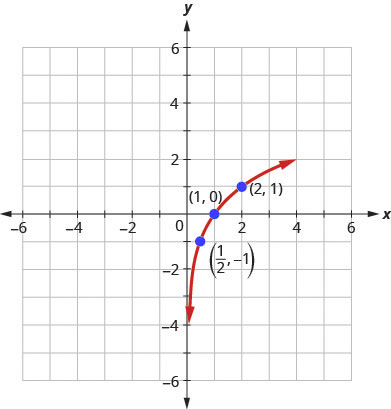
The graphs of [latex]y={log}_{2}x[/latex], [latex]y={log}_{3}x[/latex], and [latex]y={log}_{5}x[/latex] are the shape we expect from a logarithmic function where [latex]a \gt 1[/latex]. We notice that for each function the graph contains the point [latex]\left(1,0\right)[/latex]. This make sense because [latex]0={log}_{a}1[/latex] means [latex]{a}^{0}=1[/latex] which is true for any [latex]a[/latex].
The graph of each function, also contains the point [latex]\left(a,1\right)[/latex]. This makes sense as [latex]1={log}_{a}a[/latex] means [latex]{a}^{1}=a[/latex]. Which is true for any [latex]a[/latex].
Notice too, the graph of each function [latex]y={log}_{a}x[/latex] also contains the point [latex]\left(\frac{1}{a},-1\right)[/latex]. This makes sense as [latex]-1={log}_{a}\frac{1}{a}[/latex] means [latex]{a}^{-1}=\frac{1}{a}[/latex], which is true for any [latex]a[/latex].
Look at each graph again. Now we will see that many characteristics of the logarithm function are simply ’mirror images’ of the characteristics of the corresponding exponential function.
What is the domain of the function? The graph never hits the [latex]y[/latex]-axis. The domain is all positive numbers. We write the domain in interval notation as [latex]\left(0,\infty \right)[/latex].
What is the range for each function? From the graphs we can see that the range is the set of all real numbers. There is no restriction on the range. We write the range in interval notation as [latex]\left(\text{−}\infty ,\infty \right)[/latex].
When the graph approaches the [latex]y[/latex]-axis so very closely but will never cross it, we call the line [latex]x=0[/latex], the [latex]y[/latex]-axis, a vertical asymptote.
Properties of the Graph of [latex]y={log}_{a}x[/latex] when [latex]a \gt 1[/latex]
| Domain | [latex]\left(0,\infty \right)[/latex] |
|---|---|
| Range | [latex]\left(\text{−}\infty ,\infty \right)[/latex] |
| [latex]x\text{-}\text{intercept}[/latex] | [latex]\left(1,0\right)[/latex] |
| [latex]y\text{-}\text{intercept}[/latex] | None |
| Contains | [latex]\left(a,1\right)[/latex], [latex]\left(\frac{1}{a},-1\right)[/latex] |
| Asymptote | [latex]y\text{-}\text{axis}[/latex] |
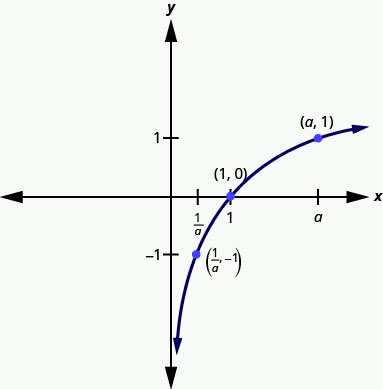
Our next example looks at the graph of [latex]y={log}_{a}x[/latex] when [latex]0 \lt a \lt 1[/latex].
Example 5.2.6
Graph [latex]y={log}_{\frac{1}{3}}x[/latex].
Solution
To graph the function, we will first rewrite the logarithmic equation, [latex]y={log}_{\frac{1}{3}}x[/latex], in exponential form, [latex]{\left(\frac{1}{3}\right)}^{y}=x[/latex].
We will use point plotting to graph the function. It will be easier to start with values of [latex]y[/latex] and then get [latex]x[/latex].
| [latex]y[/latex] | [latex]{\left(\frac{1}{3}\right)}^{y}=x[/latex] | [latex]\left(x,y\right)[/latex] |
|---|---|---|
| [latex]-2[/latex] | [latex]{\left(\frac{1}{3}\right)}^{-2}={3}^{2}=9[/latex] | [latex]\left(9,-2\right)[/latex] |
| [latex]-1[/latex] | [latex]{\left(\frac{1}{3}\right)}^{-1}={3}^{1}=3[/latex] | [latex]\left(3,-1\right)[/latex] |
| [latex]0[/latex] | [latex]{\left(\frac{1}{3}\right)}^{0}=1[/latex] | [latex]\left(1,0\right)[/latex] |
| [latex]1[/latex] | [latex]{\left(\frac{1}{3}\right)}^{1}=\frac{1}{3}[/latex] | [latex]\left(\frac{1}{3},1\right)[/latex] |
| [latex]2[/latex] | [latex]{\left(\frac{1}{3}\right)}^{2}=\frac{1}{9}[/latex] | [latex]\left(\frac{1}{9},2\right)[/latex] |
| [latex]3[/latex] | [latex]{\left(\frac{1}{3}\right)}^{3}=\frac{1}{27}[/latex] | [latex]\left(\frac{1}{27},3\right)[/latex] |
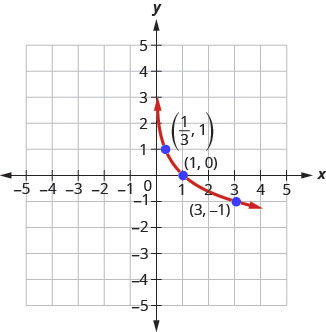
Now, let’s look at the graphs [latex]y={log}_{\frac{1}{2}}x,\;y={log}_{\frac{1}{3}}x[/latex] and [latex]y={log}_{\frac{1}{4}}x[/latex], so we can identify some of the properties of logarithmic functions where [latex]0 \lt a \lt 1[/latex]. The graphs of all have the same basic shape. While this is the shape we expect from a logarithmic function where [latex]0 \lt a \lt 1[/latex].
We notice, that for each function again, the graph contains the points, [latex]\left(1,0\right)[/latex], [latex]\left(a,1\right)[/latex], [latex]\left(\frac{1}{a},-1\right)[/latex].
This make sense for the same reasons we argued above. We notice the domain and range are also the same—the domain is [latex]\left(0,\infty \right)[/latex] and the range is [latex]\left(\text{−}\infty ,\infty \right)[/latex].
The [latex]y[/latex]-axis is again the vertical asymptote. We will summarize these properties in the chart below. Which also include when [latex]a \gt 1[/latex].
Properties of the Graph of [latex]y={log}_{a}x[/latex]
| when [latex]a \gt 1[/latex] | when [latex]0 \lt a \lt 1[/latex] | ||
|---|---|---|---|
| Domain | [latex]\left(0,\infty \right)[/latex] | Domain | [latex]\left(0,\infty \right)[/latex] |
| Range | [latex]\left(\text{−}\infty ,\infty \right)[/latex] | Range | [latex]\left(\text{−}\infty ,\infty \right)[/latex] |
| [latex]x[/latex]-intercept | [latex]\left(1,0\right)[/latex] | [latex]x[/latex]-intercept | [latex]\left(1,0\right)[/latex] |
| [latex]y[/latex]-intercept | none | [latex]y[/latex]-intercept | None |
| Contains | [latex]\left(a,1\right)[/latex], [latex]\left(\frac{1}{a},-1\right)[/latex] | Contains | [latex]\left(a,1\right)[/latex], [latex]\left(\frac{1}{a},-1\right)[/latex] |
| Asymptote | [latex]y[/latex]-axis | Asymptote | [latex]y[/latex]-axis |
| Basic shape | increasing | Basic shape | Decreasing |
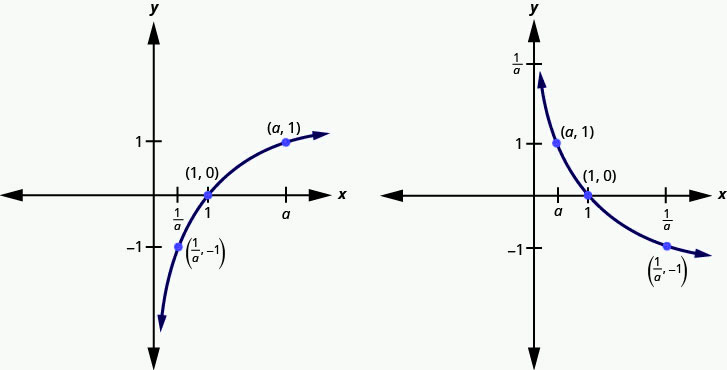
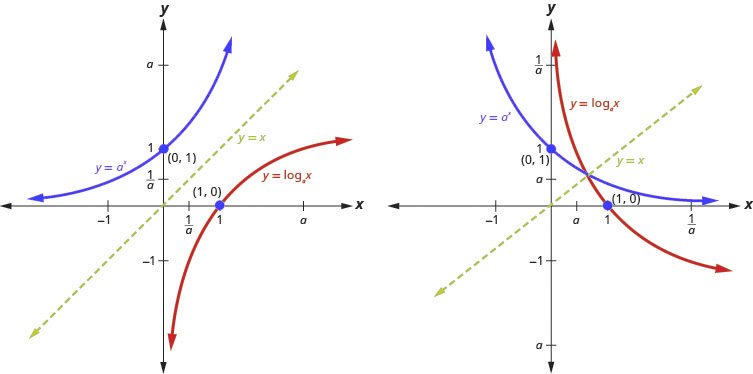
We talked earlier about how the logarithmic function [latex]{f}^{-1}\left(x\right)={log}_{a}x[/latex] is the inverse of the exponential function [latex]f\left(x\right)={a}^{x}[/latex]. The graphs in Figure 5.2.10 show both the exponential (blue) and logarithmic (red) functions on the same graph for both [latex]a \gt 1[/latex] and [latex]0 \lt a \lt 1[/latex].
Notice how the graphs are reflections of each other through the line [latex]y=x[/latex]. We know this is true of inverse functions. Keeping a visual in your mind of these graphs will help you remember the domain and range of each function. Notice the [latex]x[/latex]-axis is the horizontal asymptote for the exponential functions and the [latex]y[/latex]-axis is the vertical asymptote for the logarithmic functions.
Solve Logarithmic Equations
When we talked about exponential functions, we introduced the number [latex]e[/latex]. Just as [latex]e[/latex] was a base for an exponential function, it can be used a base for logarithmic functions too. The logarithmic function with base [latex]e[/latex] is called the natural logarithmic function. The function [latex]f\left(x\right)={log}_{e}x[/latex] is generally written [latex]f\left(x\right)=\text{ln}\;x[/latex] and we read it as “el en of [latex]x[/latex].”
Natural Logarithmic Function
The function [latex]f\left(x\right)=\text{ln}\phantom{\rule{0.2em}{0ex}}x[/latex] is the natural logarithmic function with base [latex]e[/latex], where [latex]x \gt 0[/latex].
[latex]y=\text{ln}\;x\;\text{is equivalent to}\;x={e}^{y}[/latex]
When the base of the logarithm function is [latex]10[/latex], we call it the common logarithmic function and the base is not shown. If the base [latex]a[/latex] of a logarithm is not shown, we assume it is [latex]10[/latex].
Common Logarithmic Function
The function [latex]f\left(x\right)=log\phantom{\rule{0.2em}{0ex}}x[/latex] is the common logarithmic function with base[latex]10[/latex], where [latex]x \gt 0[/latex].
[latex]y=log\;x\;\text{is equivalent to}\;x={10}^{y}[/latex]
It will be important for you to use your calculator to evaluate both common and natural logarithms. Look for the log and ln keys on your calculator.
To solve logarithmic equations, one strategy is to change the equation to exponential form and then solve the exponential equation as we did before. As we solve logarithmic equations, [latex]y={log}_{a}x[/latex], we need to remember that for the base [latex]a[/latex], [latex]a \gt 0[/latex] and [latex]a\ne 1[/latex]. Also, the domain is [latex]x \gt 0[/latex]. Just as with radical equations, we must check our solutions to eliminate any extraneous solutions.
Example 5.2.7
Solve:
a. [latex]{log}_{a}49=2[/latex]
b. [latex]\text{ln}\;x=3[/latex]
Solution
a.
Step 1: Rewrite in exponential form.
[latex]a^2=49[/latex]
Step 2: Solve the equation using the square root property.
[latex]a=\pm7[/latex]
Step 3: The base cannot be negative, so we eliminate [latex]a=-7[/latex]
[latex]a=7,\;\;\overline{)a=-7}[/latex]
Step 4: Check
[latex]\begin{align*}a&=7\\log_{\color{red}{a}}49&=2\\log_{\color{red}{7}}49&\overset?=2\\7^2&\overset?=49\\49&=49\checkmark\end{align*}[/latex]
b.
Step 1: Rewrite in exponential form.
[latex]e^3=x[/latex]
Step 2: Check
[latex]\begin{align*}x&=e^3\\\text{ln}\;{\color{red}{x}}&=3\\\text{ln}\;{\color{red}{e^3}}&\overset?=3\\e^3&=e^3\checkmark\end{align*}[/latex]
Try It
16) Solve:
a. [latex]{log}_{a}121=2[/latex]
b. [latex]\text{ln}\;x=7[/latex]
Solution
a.[latex]a=11[/latex]
b. [latex]x={e}^{7}[/latex]
Try It
17) Solve:
a. [latex]{log}_{a}64=3[/latex]
b. [latex]\text{ln}\;x=9[/latex]
Solution
a. [latex]a=4[/latex]
b. [latex]x={e}^{9}[/latex]
Example 5.2.8
Solve:
a. [latex]{log}_{2}\left(3x-5\right)=4[/latex]
b. [latex]\text{ln}\;{e}^{2x}=4[/latex]
Solution
a.
Step 1: Rewrite in exponential form.
[latex]\begin{align*}&\;&2^4&=3x-5\\&\text{Simplify.}\;\;\;&16&=3x-5\end{align*}[/latex]
Step 2: Solve the equation.
[latex]\begin{align*}21&=3x\\7&=x\end{align*}[/latex]
Step 3: Check
[latex]\begin{align*}x&=7\\log_2(3{\color{red}{x}}-5)&=4\\log_2(3\cdot{\color{red}{7}}-5)&\overset?=4\\log_2(16)&\overset?=4\\2^4&\overset?=16\\16&=16\checkmark\end{align*}[/latex]
b.
Step 1: Rewrite in exponential form.
[latex]e^4=e^{2x}[/latex]
Step 2: Since the bases are the same the exponents are equal.
[latex]4=2x[/latex]
Step 3: Solve the equation.
[latex]2=x[/latex]
Step 4: Check
[latex]\begin{align*}x&=2\\\text{ln}\;{e}^{2{\color{red}{x}}}&=4\\\text{ln}\;{e}^{2\cdot{\color{red}{2}}}&\overset?=4\\\text{ln}\;{e}^4&\overset?=4\\e^4&=e^4\checkmark\end{align*}[/latex]
Try It
18) Solve:
a. [latex]{log}_{2}\left(5x-1\right)=6[/latex]
b. [latex]\text{ln}\;{e}^{3x}=6[/latex]
Solution
a. [latex]x=13[/latex]
b. [latex]x=2[/latex]
Try It
19) Solve:
a. [latex]{log}_{3}\left(4x+3\right)=3[/latex]
b. [latex]\text{ln}\;{e}^{4x}=4[/latex]
Solution
a. [latex]x=6[/latex]
b. [latex]x=1[/latex]
Use Logarithmic Models in Applications
There are many applications that are modelled by logarithmic equations. We will first look at the logarithmic equation that gives the decibel (dB) level of sound. Decibels range from [latex]0[/latex], which is barely audible to [latex]160[/latex], which can rupture an eardrum. The [latex]{10}^{-12}[/latex] in the formula represents the intensity of sound that is barely audible.
Decibel Level of Sound
The loudness level, [latex]D[/latex], measured in decibels, of a sound of intensity, [latex]I[/latex], measured in watts per square inch is
[latex]D=10\phantom{\rule{0.2em}{0ex}}log\left(\frac{I}{{10}^{-12}}\right)[/latex]
Example 5.2.9
Extended exposure to noise that measures [latex]85[/latex] dB can cause permanent damage to the inner ear which will result in hearing loss. What is the decibel level of music coming through ear phones with intensity [latex]{10}^{-2}[/latex] watts per square inch?
Solution
[latex]D=10\log\left(\frac I{10^{-12}}\right)[/latex]
Step 1: Substitute in the intensity level, [latex]I[/latex].
[latex]{D=10}\log\left(\frac{{\color{red}{10^{-2}}}}{{10^{-12}}}\right)[/latex]
Step 2: Simplify.
[latex]D=10\log\left(10^{10}\right)[/latex]
Since [latex]log{10}^{10}=10[/latex].
[latex]D=10\times10[/latex]
Step 3: Multiply.
[latex]D=100[/latex]
The decibel level of music coming through earphones is [latex]100[/latex] dB.
Try It
20) What is the decibel level of one of the new quiet dishwashers with intensity [latex]{10}^{-7}[/latex] watts per square inch?
Solution
The quiet dishwashers have a decibel level of [latex]50[/latex] dB.
Try It
21) What is the decibel level heavy city traffic with intensity [latex]{10}^{-3}[/latex] watts per square inch?
Solution
The decibel level of heavy traffic is [latex]90[/latex] dB.
Earthquake Intensity
The magnitude [latex]R[/latex] of an earthquake is measured by a logarithmic scale called the Richter scale. The model is [latex]R=log\;I[/latex], where [latex]I[/latex] is the intensity of the shock wave. This model provides a way to measure earthquake intensity.
The magnitude [latex]R[/latex] of an earthquake is measured by [latex]R=log\;I[/latex], where [latex]I[/latex] is the intensity of its shock wave.
Example 5.2.10
In 1906, San Francisco experienced an intense earthquake with a magnitude of [latex]7.8[/latex] on the Richter scale. Over [latex]80\%[/latex] of the city was destroyed by the resulting fires. In 2014, Los Angeles experienced a moderate earthquake that measured [latex]5.1[/latex] on the Richter scale and caused [latex]\$108[/latex] million dollars of damage. Compare the intensities of the two earthquakes.
Solution
Step 1: Convert the magnitudes to intensities.
[latex]\begin{align*}&\;&R&=logI\\[2ex]&\text{1906 earthquake}\;\;\;\;\;&7.8&=logI\\&\text{Convert to exponential form.}\;\;\;\;\;&I&=10^{7.8}\\[4ex]&\text{2014 earthquake}\;\;\;\;\;&5.1&=logI\\&\text{Convert to exponential form.}\;\;\;\;\;&I&=10^{5.1}\end{align*}[/latex]
Step 2: Form a ratio of the intensities.
[latex]\frac{\text{Intensity for 1906}}{\text{Intensity for 2014}}[/latex]
Step 3: Substitute in the values
[latex]\frac{10^{7.8}}{10^{5.1}}[/latex]
Step 4: Divide by subtracting the exponents.
[latex]10^{2.7}[/latex]
Step 5: Evaluate
[latex]501[/latex]
The intensity of the 1906 earthquake was about [latex]501[/latex] times the intensity of the 2014 earthquake.
Try It
22) In 1906, San Francisco experienced an intense earthquake with a magnitude of [latex]7.8[/latex] on the Richter scale. In 1989, the Loma Prieta earthquake also affected the San Francisco area, and measured [latex]6.9[/latex] on the Richter scale. Compare the intensities of the two earthquakes.
Solution
The intensity of the 1906 earthquake was about [latex]8[/latex] times the intensity of the 1989 earthquake.
Try It
23) In 2014, Chile experienced an intense earthquake with a magnitude of [latex]8.2[/latex] on the Richter scale. In 2014, Los Angeles also experienced an earthquake which measured [latex]5.1[/latex] on the Richter scale. Compare the intensities of the two earthquakes.
Solution
The intensity of the earthquake in Chile was about [latex]1,259[/latex] times the intensity of the earthquake in Los Angeles.
Access these online resources for additional instruction and practice with evaluating and graphing logarithmic functions.
Key Concepts
- Properties of the Graph of[latex]y={log}_{a}x[/latex]:
when[latex]a \gt 1[/latex] when[latex]0 \lt a \lt 1[/latex] Domain [latex]\left(0,\infty \right)[/latex] Domain [latex]\left(0,\infty \right)[/latex] Range [latex]\left(\text{−}\infty ,\infty \right)[/latex] Range [latex]\left(\text{−}\infty ,\infty \right)[/latex] [latex]x[/latex]-intercept [latex]\left(1,0\right)[/latex] [latex]x[/latex]-intercept [latex]\left(1,0\right)[/latex] [latex]y[/latex]-intercept none [latex]y[/latex]-intercept none Contains [latex]\left(a,1\right)[/latex], [latex]\left(\frac{1}{a},-1\right)[/latex] Contains [latex]\left(a,1\right)[/latex], [latex]\left(\frac{1}{a},-1\right)[/latex] Asymptote [latex]y[/latex]-axis Asymptote [latex]y[/latex]-axis Basic shape increasing Basic shape decreasing
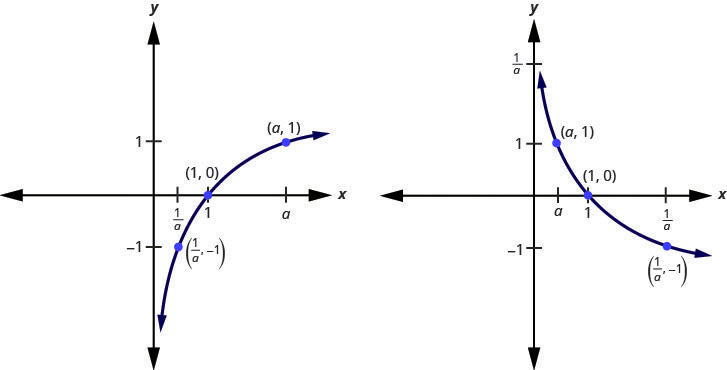
- Decibel Level of Sound: The loudness level, [latex]D[/latex], measured in decibels, of a sound of intensity, [latex]I[/latex], measured in watts per square inch is [latex]D=10log\left(\frac{I}{{10}^{-12}}\right)[/latex].
- Earthquake Intensity: The magnitude [latex]R[/latex] of an earthquake is measured by [latex]R=log\;I[/latex], where [latex]I[/latex] is the intensity of its shock wave.
Self Check
a) After completing the exercises, use this checklist to evaluate your mastery of the objectives of this section.
b) After reviewing this checklist, what will you do to become confident for all objectives?
Glossary
- common logarithmic function
- The function [latex]f\left(x\right)=log\;x[/latex] is the common logarithmic function with base[latex]10[/latex], where [latex]x \gt 0[/latex].
[latex]y=log\;x\;\text{is equivalent to}\;x={10}^{y}[/latex]
- logarithmic function
- The function [latex]f\left(x\right)={log}_{a}x[/latex] is the logarithmic function with base [latex]a[/latex], where [latex]a \gt 0[/latex], [latex]x \gt 0[/latex], and [latex]a\ne 1[/latex].
[latex]y={log}_{a}x\;\text{is equivalent to}\;x={a}^{y}[/latex]
- natural logarithmic function
- The function [latex]f\left(x\right)=\text{ln}\;x[/latex] is the natural logarithmic function with base [latex]e[/latex], where [latex]x \gt 0[/latex].
[latex]y=\text{ln}\;x\;\text{is equivalent to}\;x={e}^{y}[/latex]
The function [latex]f\left(x\right)={log}_{a}x[/latex] is the logarithmic function with base [latex]a[/latex], where [latex]a \gt 0[/latex], [latex]x \gt 0[/latex], and [latex]a\ne 1[/latex].
[latex]y={log}_{a}x\;\text{is equivalent to}\;x={a}^{y}[/latex]
The function [latex]f\left(x\right)=\text{ln}\;x[/latex] is the natural logarithmic function with base [latex]e[/latex], where [latex]x \gt 0[/latex].
[latex]y=\text{ln}\;x\;\text{is equivalent to}\;x={e}^{y}[/latex]
The function [latex]f\left(x\right)=log\;x[/latex] is the common logarithmic function with base[latex]10[/latex], where [latex]x \gt 0[/latex].
[latex]y=log\;x\;\text{is equivalent to}\;x={10}^{y}[/latex]

